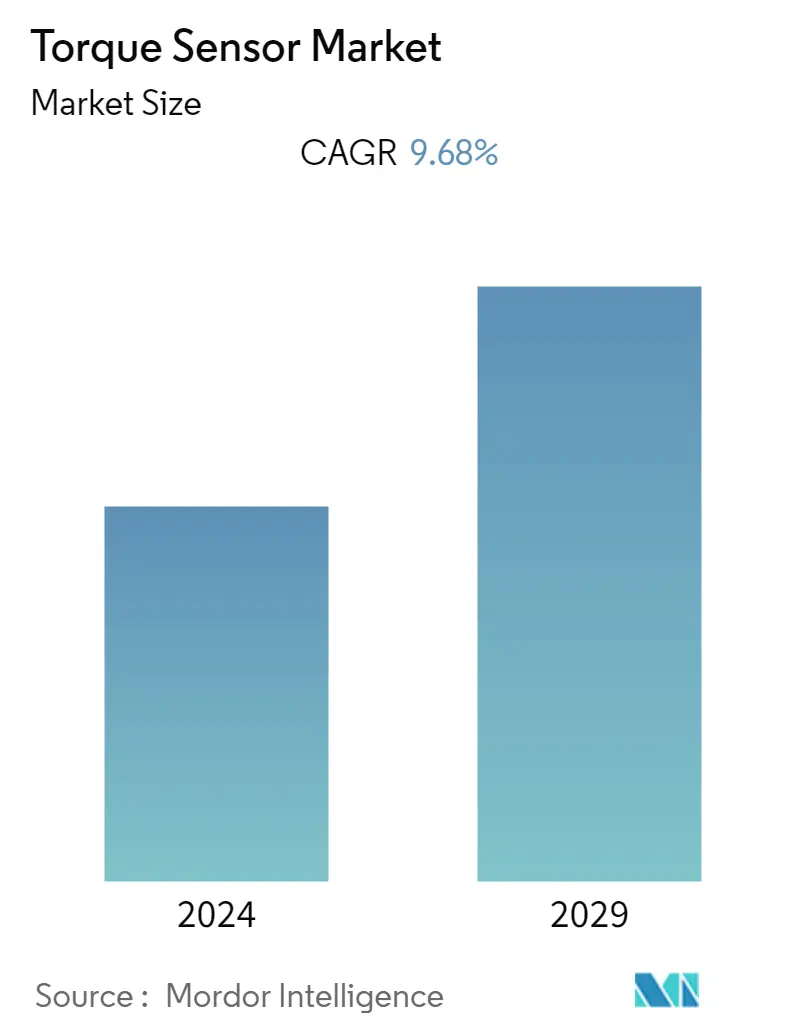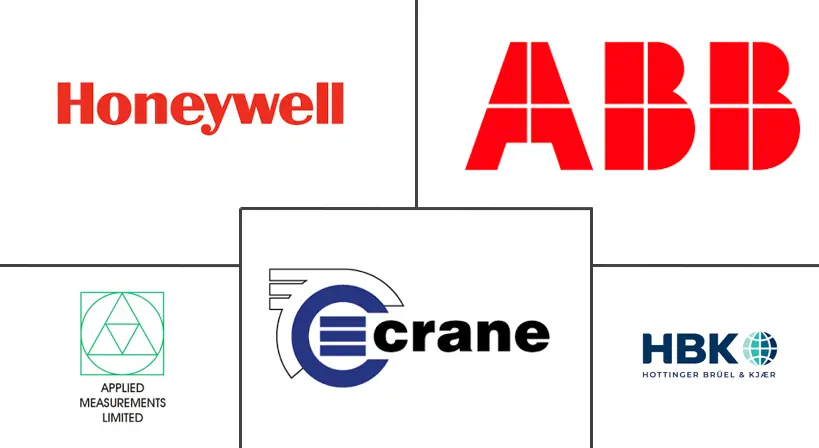Market Size of Torque Sensor Industry

| Study Period | 2019 - 2029 |
| Base Year For Estimation | 2023 |
| CAGR | 9.68 % |
| Fastest Growing Market | Asia-Pacific |
| Largest Market | Asia-Pacific |
| Market Concentration | Low |
Major Players
*Disclaimer: Major Players sorted in no particular order |
Torque Sensor Market Analysis
The torque sensor market was valued at USD 6.73 billion in 2020, and it is expected to reach USD 11.63 billion by 2026, registering a CAGR of 9.68% during the period 2021-2026. Due to the COVID-19 pandemic, the global supply chain and demand for multiple products have majorly been disrupted. The need for multiple products in various end-user industries has experienced disruption, which negatively impacted torque sensor demand and future adoption in various applications. Moreover, due to production shutdowns in countries such as China, multiple industries observed a shortage of various products during February and March 2020. Due to supply chain disruptions, the raw material prices increased, impacting the overall pricing of the sensor and related systems.
- Torque sensors measure torque through various methods. The basic principle is a mechanical process, which measures the "force" being used (or attempting) to turn an element. Also, when a force of "torque" is applied to a shaft, the shaft twists (by a minimal amount).
- Further, improvements in technology and integration of wireless and digital components into torque sensors are expected to help sustain the market's growth. Moreover, Industry 4.0, industrial automation, robotics, and smart factory concepts are increasing the market opportunities for torque sensors. The upward trend in the aerospace, automotive, and medical sectors is driving demand in the market.
- Moreover, with demand increasing for improving safety, control, and pilot operations, various aerospace companies are expected to adopt torque sensors because these sensors measure in-flight torque controls, actuation systems, and braking systems. Also, to remain competitive in the market, torque sensor vendors are coming up with new products suitable for specific applications.
- Market vendors are integrating new technologies to launch new products in the market. Most torque sensors need slip rings to transfer torque readings from the rotating shaft to the static readout. Generally, this system is noisy to use, slow to set up, and wearing parts are not always reliable. Some companies have integrated wireless technologies with surface acoustic wave (SAW) detection to overcome these challenges.
- For instance, in December 2020, UK sensor manufacturer, Sensor Technology, announced a new generation of non-contact torque sensors based on four-element strain gauge bridges that complement its existing non-contact sensors, which use surface acoustic waves (SAW) detection, but offer improved accuracy for the same price.
- One of the significant challenges the market faces is the challenge posed by the technology due to the diversity of applications of torque sensors. Due to diverse applications in different environments, the accuracy and reliability of these sensors get compromised. Moreover, electric vehicle drives run at significantly higher rotational speeds, creating challenges for torque sensors.
- Furthermore, surgeons demand devices in the medical industry to allow precise control and repeatable movement, usually in a compact footprint. Torque sensors coupled with advanced electronics can help provide such capabilities. These sensor developers encounter engineering challenges integrating them into the devices, particularly for surgical robotics. For instance, measuring the torque moment is critical to ensure that robotic tools can perform precise and seamless movements, but incorporating sensors into these complex medical systems creates challenges for the developers.
Torque Sensor Industry Segmentation
The study tracks revenues generated by vendors manufacturing and providing torque sensors for various applications in industries, such as automotive, aerospace and defense, and manufacturing, among others. Actuators are excluded from the scope of the study, and transducers mentioned in the study are exclusively for sensors. Further, the market estimation tracks the revenue from torque sensors offered to different end-user applications' customers. The revenues tracked for the study exclusively include hardware. Moreover, torque sensors used in surgical robots are considered under the medical application segment. In contrast, other robots, such as collaborative robots that use torque sensors, are considered under the other applications segment. The report covers and analyses the impact of the COVID-19 pandemic on the market, its stakeholders, and the same has been considered while arriving at the current market estimation and for future projections.
| By Product Type | |
| Reaction Torque | |
| Rotational Torque |
| By Application | |
| Automotive | |
| Aerospace | |
| Manufacturing | |
| Medical | |
| Other Applications |
| By Geography | |
| North America | |
| Europe | |
| Asia Pacific | |
| Rest of the World |
Torque Sensor Market Size Summary
The torque sensor market is poised for significant growth, driven by advancements in technology and increasing demand across various sectors. These sensors, which measure the force applied to turn an element, are becoming integral in industries such as aerospace, automotive, and medical. The integration of wireless and digital components is enhancing their functionality, making them crucial for applications in industrial automation, robotics, and smart factories. Despite challenges posed by the COVID-19 pandemic, which disrupted supply chains and increased raw material costs, the market is expected to recover and expand. The automotive industry, in particular, is a major contributor to this growth, with the rising production of vehicles and the demand for electric vehicles driving the need for torque sensors in applications like steering wheel rotation and powertrain testing.
In addition to the automotive sector, the industrial automation and robotics industries in countries like Japan, South Korea, China, and India are rapidly adopting torque sensors to enhance production efficiency. The market is characterized by intense competition, with numerous vendors focusing on developing innovative solutions to meet diverse application needs. Strategic partnerships and technological advancements, such as non-contact torque sensors and improved safety features, are further propelling market growth. As industries continue to embrace automation and smart technologies, the demand for torque sensors is expected to rise, offering substantial opportunities for market players.
Torque Sensor Market Size - Table of Contents
-
1. MARKET INSIGHTS
-
1.1 Market Overview
-
1.2 Industry Attractiveness - Porter's Five Forces Analysis
-
1.2.1 Bargaining Power of Suppliers
-
1.2.2 Bargaining Power of Buyers
-
1.2.3 Threat of New Entrants
-
1.2.4 Threat of Substitutes
-
1.2.5 Intensity of Competitive Rivalry
-
-
1.3 Assessment of the COVID-19 Impact on the Market
-
1.4 Industry Value Chain Analysis
-
1.5 Technology Snapshot
-
1.5.1 Magnetoelastic
-
1.5.2 Strain Gauge
-
-
-
2. MARKET SEGMENTATION
-
2.1 By Product Type
-
2.1.1 Reaction Torque
-
2.1.2 Rotational Torque
-
-
2.2 By Application
-
2.2.1 Automotive
-
2.2.2 Aerospace
-
2.2.3 Manufacturing
-
2.2.4 Medical
-
2.2.5 Other Applications
-
-
2.3 By Geography
-
2.3.1 North America
-
2.3.2 Europe
-
2.3.3 Asia Pacific
-
2.3.4 Rest of the World
-
-
Torque Sensor Market Size FAQs
What is the current Torque Sensor Market size?
The Torque Sensor Market is projected to register a CAGR of 9.68% during the forecast period (2024-2029)
Who are the key players in Torque Sensor Market?
ABB Ltd, Crane Electronics Ltd, HBK Benelux (Spectris PLC), Applied Measurements Ltd and Honeywell International are the major companies operating in the Torque Sensor Market.

